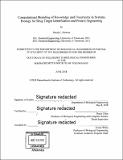| dc.contributor.advisor | Bruce Tidor. | en_US |
| dc.contributor.author | Flowers, David Christopher, 1988- | en_US |
| dc.contributor.other | Massachusetts Institute of Technology. Department of Biological Engineering. | en_US |
| dc.date.accessioned | 2019-01-11T16:06:15Z | |
| dc.date.available | 2019-01-11T16:06:15Z | |
| dc.date.copyright | 2018 | en_US |
| dc.date.issued | 2018 | en_US |
| dc.identifier.uri | http://hdl.handle.net/1721.1/119969 | |
| dc.description | Thesis: Ph. D., Massachusetts Institute of Technology, Department of Biological Engineering, 2018. | en_US |
| dc.description | Cataloged from PDF version of thesis. | en_US |
| dc.description | Includes bibliographical references (pages 72-76). | en_US |
| dc.description.abstract | In systems biology, ordinary differential equation models are used frequently to model the dynamics of molecular and cellular systems. These models are parameterized with rate constants and other quantities that are often estimated from empirical data. When the data are insufficient to fully determine the model parameters, the parameter values are unidentifiable, and many parameter sets are consistent with the data. To cope, many studies sample a collection of parameters to represent the uncertainty or simplify the model to remove parameters. Studies rarely verify that their sampling is sufficient or test alternative model simplifications. There is a need for better practices for uncertainty quantification. In this work, I present two case studies demonstrating the use of biochemical models with unidentifiable parameters to make useful predictions. The first study investigates a model of the complement system, a system of circulating proteins involved in immune response, to find promising drug targets for treatment of sepsis. I compared a sampling method to a worst-case search method for quantifying the uncertainty in responses to hypothetical inhibitors and found that the choice of method significantly impacts the results. I identified mechanistic explanations for the observed inhibitor responses that demonstrate limitations of intuition and suggest strategies for further studies. The second study uses a kinetic model of the thiolase and reductase enzymes of the 3-hydroxyacid metabolic pathway to interpret available in vitro data to determine the kinetic changes induced by a mutation in the thiolase. Sampling approaches cannot identify all combinations of rate constants that could have changed according to the data, so I perform a selective enumeration strategy that identifies all feasible combinations by testing only a limited number. The simplest feasible combinations identify three classes of rate constant changes induced by the mutation. I also use a global sensitivity analysis approach to predict which reaction steps are most likely to positively affect the product selectivity ratio of the system. Together, these studies demonstrate that unidentifiable models can be useful if the correct methods are chosen to quantify their uncertainty and serve as examples of how to choose or design these methods. | en_US |
| dc.description.statementofresponsibility | by David C. Flowers. | en_US |
| dc.format.extent | 88 pages | en_US |
| dc.language.iso | eng | en_US |
| dc.publisher | Massachusetts Institute of Technology | en_US |
| dc.rights | MIT theses are protected by copyright. They may be viewed, downloaded, or printed from this source but further reproduction or distribution in any format is prohibited without written permission. | en_US |
| dc.rights.uri | http://dspace.mit.edu/handle/1721.1/7582 | en_US |
| dc.subject | Biological Engineering. | en_US |
| dc.title | Computational modeling of knowledge and uncertainty in systems biology for drug target identification and protein engineering | en_US |
| dc.type | Thesis | en_US |
| dc.description.degree | Ph. D. | en_US |
| dc.contributor.department | Massachusetts Institute of Technology. Department of Biological Engineering | |
| dc.identifier.oclc | 1080639043 | en_US |
